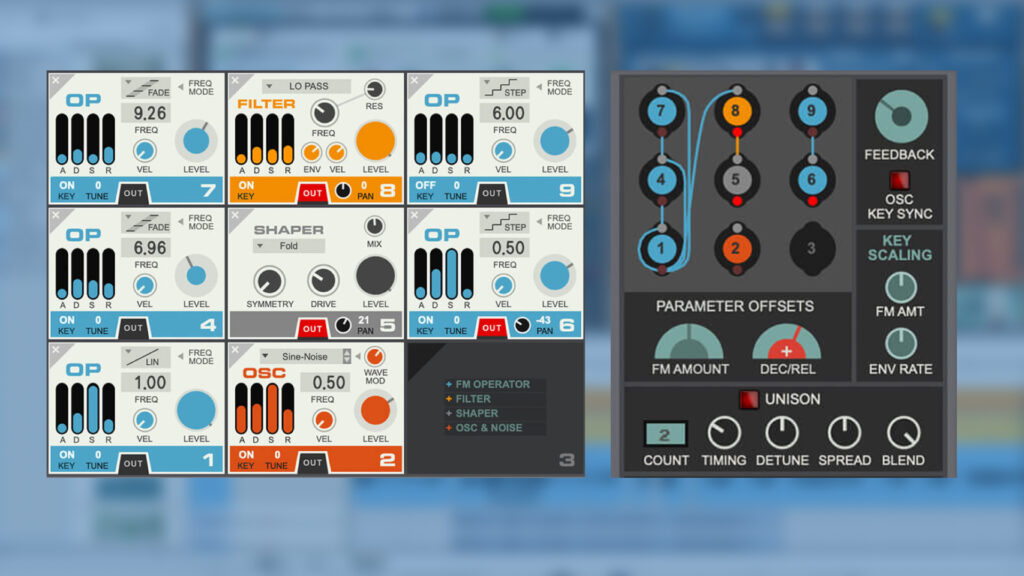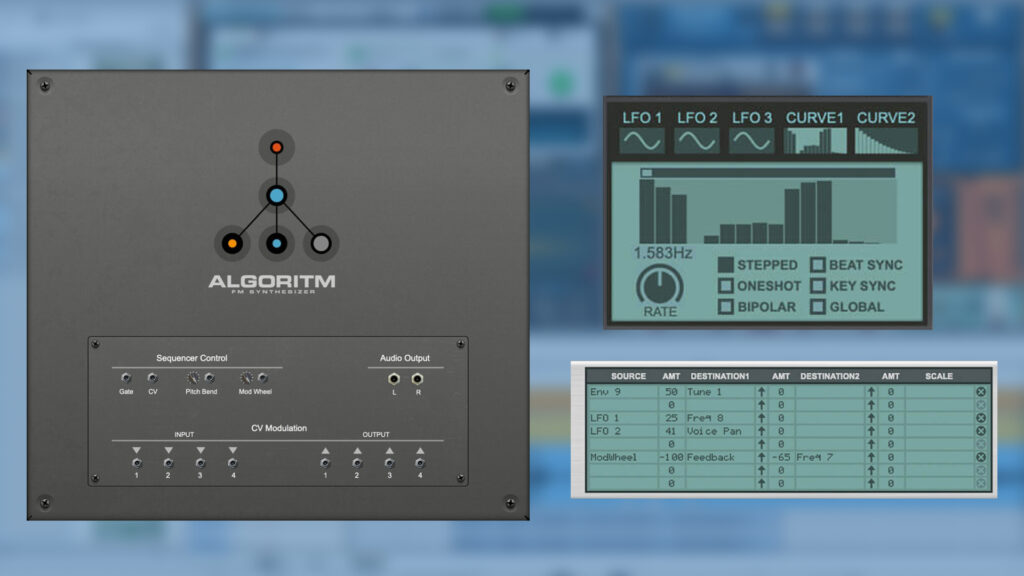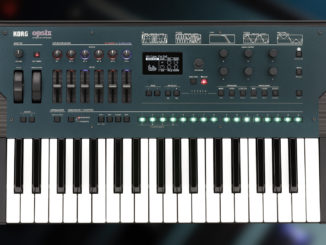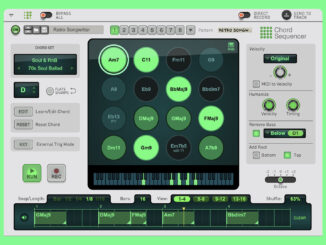Review: Reason Studios Algoritm unique hybrid synth engine and visual design makes FM synthesis more accessible, logical, and flexible
Complicated, complex, mathematical and confusing. Words like this are often heard when musicians talk about their first experiences with FM synthesis. I have to admit, it was no different for me at first. I made my first step with the Native Instruments FM7/FM8. In the last two years, however, there has been a turnaround in the market. FM synthesis is back in new clothes.
We continue to deal with operators and sine waves. Companies doesn’t reinvented the synthesis from scratch. However, they have been put into more manageable packages, making the concept much more logical and simple. A perfect example is Korg latest hardware synth opsix, a programmable, fun, and easy-to-use FM Synthesizer. No joke, they did it. Full review is online here.

And Reason Studios takes the same approach with its Algoritm rack extension. Away from overloaded menus, towards tidy, beautiul interfaces, more flexibility in the operators… Here is a full Reason Studios Algoritm review with everything you need to know.
Reason Studios Algoritm
Algoritm’s core consists of nine flexible operator-module slots. An operator-module can be a classic FM oscillator with different frequency modes, a wavetable + noise oscillator, a multimode filter, or a multi-type waveshaper. The arrangement plays no role, or let’s say little if you like a preferred arrangement. Of course, you get your ADSR envelope per oscillator operator as well as more in-depth parameters like tune, frequency mode… Basically functions you actually know from FM synths.
Then, each operator-module has an input and output with the option to turn it in or off. This gives you option to hear the pure oscillator (on mode) or only the effects of the modulation (off). Where things get more unique is when you start working with wavetables. Here you go beyond classic FM synthesis. They offer a wide range of tables including….
The interesting thing is: you can use them as a sound generator or as a modulator. This opens up many new sound doors especially in layering sounds. Thus, you are not limited to the 80s FM sounds, you can design patches with hybrid structures. For example, a massive VA pad with crystal-like shining textures in the background.

Filtering & Shaping
Filters were a taboo subject in the early days of FM synthesis. In modern versions they are indispensable. In Algoritm you have a filter with an envelope and a waveshaper module. And that’s a lot of fun. Starting with the filter. On the one hand, you can take the sharpness out of very high-frequency sounds.That can be very useful.
On the other, it’s an essential part to transform Algo in a wavetable/VA Synthesizer with multiple oscillators, filters…in no time. The modules and the patch matrix make it possible. And so VA and FM sounds live together or separately, depending on how you set it up.
Not only can you filter out harmonics from the oscillators, you can also simply add them with the waveshaper module. It basically pulls Algoritm into the west-coast synthesis field. Where sine waves live with waveshapers in a close, harmonious relationship.
Patching
Patching happens in the virtual patch matrix, which is heavily inspired by a modular synth. Modules can be patched freely using patch cables without the fixed 28 or 32 algorithm constraint of the past.
Here you build your own algorithm: a patch with three individual sounds, one with tons of active feedbacks, and modulations… everything is possible. You are the Dr. Algorithm. There is a dedicated feedback knob for adjusting the amount and a unison (4 max) function for juicy, mighty sounds as well. Patching is super straightforward, flexible and logical.

Modulation
On the modulation side, you get three built-in multi-wave LFOs with rate, delay and sync option. If you like it more complex, there are two fully customizable curve generators with 16 steps that can generate advanced movements. Especially useful when creating musical modulations like a filter that moves with the rhythm.
A modulation matrix takes over the mappings, which is known from other Reason synthesizers. Not to forget, on the back there are four virtual CV ins and outs. If the available ones are not enough, you can simply integrate more modulators here. From Reason’s internal arsenal or from the large range of third-party rack extensions.
Effects
Effects are rather basic. You have classic algorithms like a distortion, EQ, phaser, compressor, delay, and reverb. They sound solid and refine the sound well. Alternatively, you can integrate other effects using other internal or third-party rack extensions. An advantage of the Reason cosmos.
A highlight in my opinion is the convolution-based resonator with 21 built-in resonator types. With these, sounds can be pushed in realistic directions. Say hello to physical modeling-like effects. You can achieve, for example, very beautiful, acoustically similar instruments. You can hear the result in the video demo.

Randomizer
Patching a synth can take time. To speed this up, Reason Studios has built in a clever randomizer. It features several options, including freq, mode, level, env, and algorithm. The operation is simple: highlight your favorite settings and drag the randomizer bar to the right. Algorithm then randomizes the parameters according to the given menu. Additionally, you can tap inside bar that gives you new sounds spontaneously.
The function is beautifully designed, because on the one hand you can randomize everything as usual, but also only specific features with self-defined intensity. Thus, I can achieve complete chaos with one random round or slight modifications to the existing sound. The latter is very inspiring and it also applies to the patch matrix. So you can create new algorithm variation with a single click. A nice idea to come up with new timbres.
Sounds
The strength of Algoritm is its hybrid structure that covers a wide sonic spectrum. Starting with all the beautiful 80s FM sounds you know from DX-7 and other synthesizers. Punchy basses, bells, metallic timbres… Yes, it also masters virtual analog sounds with lots of juice and thickness.
Same applies for west-coast-style patches. The waveshapers gives you near endless room for creating Buchlaresque tones with all their beloved bizarre and harmonically rich content. Or you go all-in and combine everything in a massive hybrid patch.
Reason Studios Algoritm Review
Reason Studios has archived to make FM synthesis simpler, more logical and modern. The name of the synth sounds complex, but it isn’t. Algoritm lets you go deeper, yes really deep, but the stages are lot easier to master than in the legendary FM synths of yesteryear.
Knowing the concept of FM synthesis is an advantage, but not a must. With the virtual patch interface you can playfully discover it step by step. And unlike classic FM synths, Reason’s virtual instrument is not limited to operators with sine waves. It offers wavetables, filtering and Buchla-style waveshaping. Ideas that shoot FM synthesis in new areas.
Algoritm is great overall package. Almost modular, hybrid thanks to multiple synthesis types, and a solid pack of modulators and effects. And with Reason 11/12’s internal features, Algoritm can be easily rebuilt into a multi-layer synth with more modulators and effects. Unfortunately not a standalone plugin, but at least you have the Reason Rack plugin with which the synth also runs in Ableton Live, Logic Pro etc.
Pro
- easy-to-use FM Synthesizer
- hybrid FM synthesis with wavetables, filtering and waveshaping
- modular concept
- Korg opsix spirit
- clever randomizer
Neutral
- updates in future with new features?
Contra
- not a standalone plugin, only in the Reason DAW or in the Rack plugin
- not included in Reason 12 (standard)
Reason Algoritm is available now for 109€ and runs in Reason 11 and higher If you read this review until January 25th, 2021, you can benefit from a special offer where you get Algoritm for free with a purchase of Bassline Generator (74€). So you can save 60% OFF. Algorithm requires a license of Reason.
More information here: Reason Studios
Reason Studio is also available at our partners




Gut gemacht Tom! (Sorry, don’t know that in Luxembourgish) I coincidentally just picked this up a few days before you posted this. It really is pretty open-ended for programming and a great tool for more easily understanding FM. Though I’ve done some FM programming with the PX7 RE and FM7/8, this presents FM synthesis in one of the most straight forward ways I’ve seen.
Though I’m less-than-crazy about Reason’s new subscription model, they’re at least still producing some cool tools.